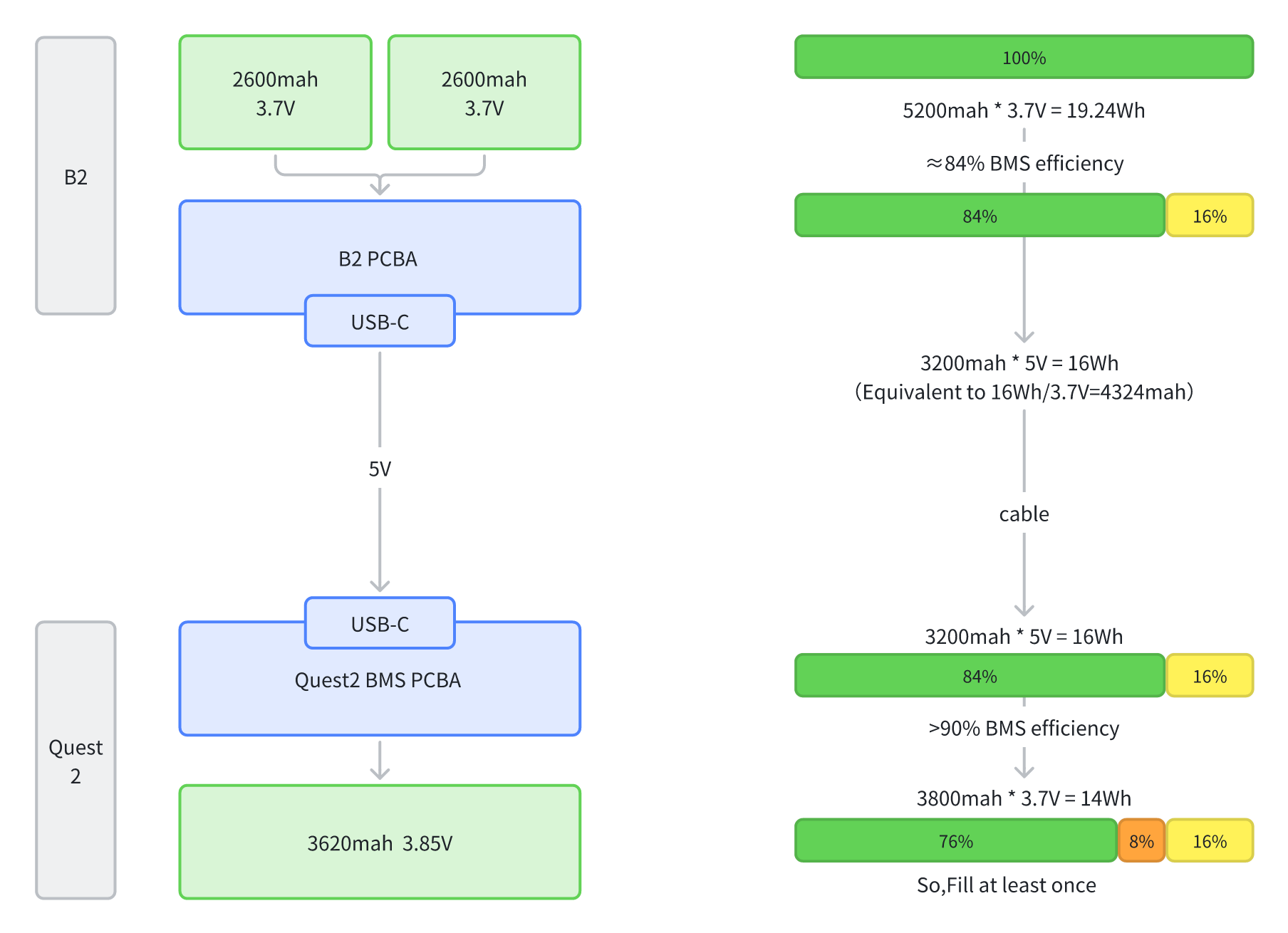Looking for help?
Find answers to your questions
- Why Three Beeps
- B2-Product List
- B2-Lights
- B2-How To Calibrate
- B2-Inputs And Outputs
- B2-Charge FAQ
- B2 - Charge
- Beep Always
- Connection Cable Faulty
- B2-Power Supply
- Sounds In B2
- B2-Fault Index
- Battery Dock Upgrade Kit
- Twin Charger Station-FAQ
- Twin Charger Station
- P4-Product List
- P4- How To Install
- P4-FAQ
B2-Inputs And Outputs
Important note: All power banks sold in the market have output losses, which is why the output capacity of all power banks is much lower than the rated capacity. Currently, the output efficiency of B2 is considered relatively excellent in the industry, with a loss rate of only about 16%, while many low-end ones exceed 20%.
Capacity parameters of the B2 battery:
Cell capacity: 5200mAh, 3.7V, 19.24Wh Rated capacity: 3200mAh, 5V/1.5A, 16Wh
The difference between rated capacity and battery capacity:
-
Battery capacity is one of the important performance indicators to measure the performance of the battery, which indicates the amount of electricity discharged by the battery under certain conditions, i.e., the capacity of the battery, usually measured in Ampere-hour, the formula for calculating the capacity of the battery pack is: Battery Pack Capacity (Ah) = Battery Unit Capacity (Ah) x Number of Battery Units (pcs) x Number of Battery Packs Parallel Connected (Groups). That is, B2 cell capacity = 2600mAh * 2 (individual) * 1 (group) = 5200mAh
Battery capacity = power ÷ voltage. For example: B2 cell capacity = 19.24Wh ÷ 3.7V = 5.2Ah = 5200mAh
-
Rated capacity means that the motor or appliance indicated on the nameplate can work continuously for a long time under rated working conditions.
-
Battery capacity is divided into actual capacity, theoretical capacity and rated capacity according to different conditions.
-
Battery pack capacity test instructions
Rated power = rated capacity × rated voltage = 3200mAh × 5V = 16Wh
Output efficiency = rated power ÷ cell power = 16Wh ÷ 19.24Wh ≈ 0.84=84%.
Input Capacity = cell Power ÷ cell Voltage = 19.24Wh ÷ 3.7V = 5200mAh (If the input voltage is 5V, the ideal capacity of the battery with 0 loss = 19.24Wh ÷ 5V = 3.848Ah = 3848mAh)
Cell capacity: 5200mAh can only be achieved with standard 3.7V voltage.
Explanation
-
B2 battery = cell + BMS PCBA (composition) (cell: 5200mAh because of the heat and output loss of the BMS PCBA, that is, the output efficiency of the cell to the BMS PCBA is only: 5200mAh × 84% ≈ 4300mAh × 3.7V = 16Wh)
-
Quest 2 battery power = 3640mAh × 3.85V = 14Wh (B2 battery can charge the Quest 2 ≈ 105%, B2 battery output power to the Quest 2 = 14Wh × 105% = 14.7Wh, B2 battery output efficiency = 14.7Wh ÷ 16Wh ≈ 0.91 = 91%)
-
Quest 2 = battery cell + BMS PCBA (composition) (battery capacity output to Quest 2: 16Wh ÷ 3.7V ≈ 4.324Ah = 4324mAh, because the output efficiency of the B2 battery output to the Quest 2 is: 91%, so: 4324mAh ≈ 91% ≈ 3935mAh ≈ 3.7V ≈ 14.6Wh)
-
The minimum capacity of the battery: 5000mAh

If the B2 battery needs to charge Quest 2, its path and its loss: B2 battery cell 5200mAh 3.7V to B2 BMS PCBA output and heat and loss, the estimated output efficiency is 84%, through the USB Line (a small amount of loss), connected to the Quest 2 BMS PCBA, due to heat loss, the voltage is converted from 5V to 3.7V input, the estimated input efficiency is 91% to Quest 2 cell
Therefore: 5200mAH battery after a series of loss of the actual charging capacity to the device only: 3.7V 3900mAh-4000mAh or so, B2 battery output loss is expected to be 16%.

Updated on 20 Oct 2023
What are your Feelings?
Thanks for your feedback.
- Choosing a selection results in a full page refresh.







